Critical residues within the BTB domain of PLZF and Bcl-6 modulate interaction with corepressors
- PMID: 11865059
- PMCID: PMC135611
- DOI: 10.1128/MCB.22.6.1804-1818.2002
Critical residues within the BTB domain of PLZF and Bcl-6 modulate interaction with corepressors
Abstract
The PLZF (promyelocytic leukemia zinc finger) transcriptional repressor, when fused to retinoic acid receptor alpha (RARalpha), causes a refractory form of acute promyelocytic leukemia. The highly conserved N-terminal BTB (bric a brac, tramtrack, broad complex)/POZ domain of PLZF plays a critical role in this disease, since it is required for transcriptional repression by the PLZF-RARalpha fusion protein. The crystal structure of the PLZF BTB domain revealed an obligate homodimer with a highly conserved charged pocket formed by apposition of the two monomers. An extensive structure-function analysis showed that the charged pocket motif plays a major role in transcriptional repression by PLZF. We found that mutations of the BTB domain that neutralize key charged pocket residues did not disrupt dimerization, yet abrogated the ability of PLZF to repress transcription and led to the loss of interaction with N-CoR, SMRT, and histone deacetylases (HDACs). We extended these studies to the Bcl-6 protein, which is linked to the pathogenesis of non-Hodgkin's lymphomas. In this case, neutralizing the charged pocket also resulted in loss of repression and corepressor binding. Experiments with purified protein showed that corepressor-BTB interactions were direct. A comparison of the PLZF, Bcl-6, and the FAZF (Fanconi anemia zinc finger)/ROG protein shows that variations in the BTB pocket result in differential affinity for corepressors, which predicts the potency of transcriptional repression. Thus, the BTB pocket represents a molecular structure involved in recruitment of transcriptional repression complexes to target promoters.
Figures
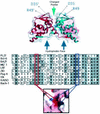
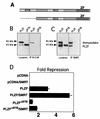
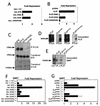

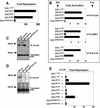
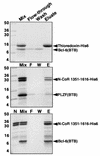
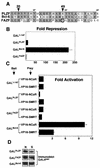

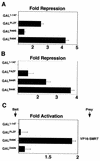
Similar articles
-
In-depth mutational analysis of the promyelocytic leukemia zinc finger BTB/POZ domain reveals motifs and residues required for biological and transcriptional functions.Mol Cell Biol. 2000 Sep;20(17):6550-67. doi: 10.1128/MCB.20.17.6550-6567.2000. Mol Cell Biol. 2000. PMID: 10938130 Free PMC article.
-
Recruitment of SMRT/N-CoR-mSin3A-HDAC-repressing complexes is not a general mechanism for BTB/POZ transcriptional repressors: the case of HIC-1 and gammaFBP-B.Proc Natl Acad Sci U S A. 1999 Dec 21;96(26):14831-6. doi: 10.1073/pnas.96.26.14831. Proc Natl Acad Sci U S A. 1999. PMID: 10611298 Free PMC article.
-
The BCL-6 POZ domain and other POZ domains interact with the co-repressors N-CoR and SMRT.Oncogene. 1998 Nov 12;17(19):2473-84. doi: 10.1038/sj.onc.1202197. Oncogene. 1998. PMID: 9824158
-
N-CoR-HDAC corepressor complexes: roles in transcriptional regulation by nuclear hormone receptors.Curr Top Microbiol Immunol. 2003;274:237-68. doi: 10.1007/978-3-642-55747-7_9. Curr Top Microbiol Immunol. 2003. PMID: 12596910 Review.
-
Biological roles and mechanistic actions of co-repressor complexes.J Cell Sci. 2002 Feb 15;115(Pt 4):689-98. doi: 10.1242/jcs.115.4.689. J Cell Sci. 2002. PMID: 11865025 Review.
Cited by
-
NLRP7, Involved in Hydatidiform Molar Pregnancy (HYDM1), Interacts with the Transcriptional Repressor ZBTB16.PLoS One. 2015 Jun 29;10(6):e0130416. doi: 10.1371/journal.pone.0130416. eCollection 2015. PLoS One. 2015. PMID: 26121690 Free PMC article.
-
Sequence and structural analysis of BTB domain proteins.Genome Biol. 2005;6(10):R82. doi: 10.1186/gb-2005-6-10-r82. Epub 2005 Sep 15. Genome Biol. 2005. PMID: 16207353 Free PMC article.
-
MicroRNA (miRNA)-mediated interaction between leukemia/lymphoma-related factor (LRF) and alternative splicing factor/splicing factor 2 (ASF/SF2) affects mouse embryonic fibroblast senescence and apoptosis.J Biol Chem. 2010 Dec 10;285(50):39551-63. doi: 10.1074/jbc.M110.114736. Epub 2010 Oct 4. J Biol Chem. 2010. PMID: 20923760 Free PMC article.
-
Epigenetics of cervical cancer. An overview and therapeutic perspectives.Mol Cancer. 2005 Oct 25;4:38. doi: 10.1186/1476-4598-4-38. Mol Cancer. 2005. PMID: 16248899 Free PMC article. Review.
-
Expanding roles for ThPOK in thymic development.Immunol Rev. 2010 Nov;238(1):182-94. doi: 10.1111/j.1600-065X.2010.00958.x. Immunol Rev. 2010. PMID: 20969593 Free PMC article. Review.
References
-
- Barna, M., N. Hawe, L. Niswander, and P. P. Pandolfi. 2000. Plzf regulates limb and axial skeletal patterning. Nat. Genet. 25:166-172. - PubMed
-
- Cattoretti, G., C. C. Chang, K. Cechova, J. Zhang, B. H. Ye, B. Falini, D. C. Louie, K. Offit, R. S. Chaganti, and R. Dalla-Favera. 1995. BCL-6 protein is expressed in germinal-center B cells. Blood 86:45-53. - PubMed
Publication types
MeSH terms
Substances
Grants and funding
LinkOut - more resources
Full Text Sources
Other Literature Sources
Research Materials
Miscellaneous
